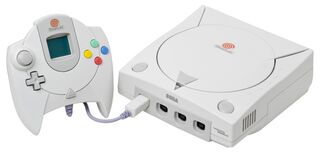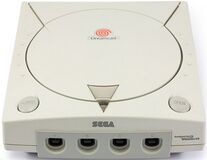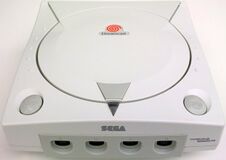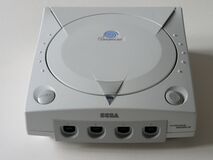Sega Dreamcast
From Sega Retro

| |||||||||||||||||||||||||||||||||||||||||||||||||||||||
| Sega Dreamcast | |||||||||||||||||||||||||||||||||||||||||||||||||||||||
|---|---|---|---|---|---|---|---|---|---|---|---|---|---|---|---|---|---|---|---|---|---|---|---|---|---|---|---|---|---|---|---|---|---|---|---|---|---|---|---|---|---|---|---|---|---|---|---|---|---|---|---|---|---|---|---|
| Manufacturer: Sega | |||||||||||||||||||||||||||||||||||||||||||||||||||||||
| Variants: Sega NAOMI, Atomiswave, Sega Aurora | |||||||||||||||||||||||||||||||||||||||||||||||||||||||
|
The Sega Dreamcast (ドリームキャスト) is a home video game console manufactured by Sega as a successor to the Sega Saturn. It was originally released in November 1998, becoming first machine to be released in what is now known as the sixth generation of video game consoles, sharing a platform with the PlayStation 2, Nintendo GameCube and the Xbox.
The Dreamcast was Sega's last home console. The first few years went well, but then the PlayStation 2 happened, killing Sega's livelihood overnight. Going into 2001, the Dreamcast was cancelled, with Sega pulling out of the console hardware business it had been pursuing for nearly twenty years. Roughly 10.6 million Dreamcast consoles had been sold worldwide.
An arcade counterpart to the Dreamcast exists as the Sega NAOMI.
Contents
Hardware
The Dreamcast is a small, white box with aesthetics designed to appeal to a wide-ranging audience. It was envisioned as an "128-bit" "super console", designed to leapfrog "32-bit" and "64-bit" contemporaries in the form of the PlayStation and Nintendo 64, respectively (although from a technical standpoint, its main processor deals in 32-bit or 64-bit instructions, with the 128-bit figure coming from the graphics hardware). Incidentally the Dreamcast was the last home console to use "bits" as a selling point, with processing capabilities now typically measured in other ways.
Taking design cues from the Nintendo 64 and the Sega Saturn, the Dreamcast contains four control ports, a removable modem, disc drive and an extension port (as well as the expected AV and power inputs). It is not backwards compatible with any prior Sega hardware or software (although its controller derives from the Saturn's 3D Control Pad), and operates in much the same way as the Saturn (and PlayStation) does, with a configurable settings and memory management accessed through a BIOS screen.
The Dreamcast uses a proprietary format of storage called GD-ROMs for games in order to circumvent software piracy, a strategy that ultimately backfired when the first run of discs had a high rate of defects. The format was also cracked fairly quickly (and in some cases, the pirated games were released before the legitimate versions). Sega largely had themselves to blame for the high levels of Dreamcast piracy—their use of the GD-ROM format was completely undermined by the console's support for the Mil-CD format, which allowed the console to boot from a standard CD-R. Mil-CD support was removed from the final Dreamcast revisions toward the end of the console's life.
The GD-ROM format also put the console at a disadvantage when competing against the PlayStation 2 - the PS2 used DVDs, and could therefore run DVD videos making it an inexpensive DVD player as well as a video game console. DVD-ROMs also have more storage space, allowing for bigger games (though the initial run of PS2 games used a blue CD-ROM format). Sega looked into DVD technology during the Dreamcast's development but claimed it was too expensive.
The Dreamcast was the first video game console to ship with a built-in 56k modem, with broadband adapters being made available later on in certain regions. This allowed the system to connect to the internet using a custom, fully-functional web browser and e-mail client. Many games released for the Dreamcast shipped with online play modes, the most popular being Phantasy Star Online and the Sega Sports lineup (now published under the ESPN label). Although other consoles before the Dreamcast had network gaming support, such as the Sega Saturn's NetLink and the Sega Mega Drive's XB∀ND, the Dreamcast was the first game console to include this ability out of the box and is therefore considered the first internet-enabled home game system.
The Dreamcast has a modest hacking enthusiast community. The availability of Windows CE software development kits on the Internet—as well as ports of Linux (LinuxDC) and dreamcast NetBSD operating systems to the Dreamcast—gave programmers a selection of familiar development tools to work with, even though they do not really support the high speed graphics. A homebrew minimal operating system called Kallistios offers support for most hardware, while not offering multi-tasking, which is superfluous for games. Many emulators and other tools (MP3, DivX players, and image viewers) have been ported to or written for the console, taking advantage of the relative ease with which a home user can write a CD which is bootable by an unmodified Dreamcast.
Sega released an arcade board, using the same technology as the Dreamcast, called Sega NAOMI, leading to many Dreamcast-exclusive games with a high level of arcade quality. They later packaged the Dreamcast into an arcade board as the Atomiswave.
The Dreamcast was the most powerful home system at the time of its release in 1998 and 1999 (surpassed only by arcade systems like the Model 3 Step 2, NAOMI, and Hikaru). The most powerful PC CPU of 1999, the Pentium III 800, was capable of 800 MFLOPS[6][7] and calculating 5.4 million polygons/sec geometry (3.75 million polygons/sec geometry for Pentium III 550),[8] compared to the Dreamcast's Hitachi SH-4 which was capable of 1400 MFLOPS and calculating more than 10 million polygons/sec geometry.[9] The most powerful PC graphics chip at the time of its North American release in September 1999, the Voodoo3 3500, had a peak rendering fillrate of 183 megapixels/sec, compared to the CLX2's peak fillrate of over 3200 megapixels/sec with opaque polygons[9] and 500 megapixels/sec[10] with translucent polygons. The CLX2 also supports VQ texture compression, with twice the compression ratio (8:1) of the Voodoo3's compression algorithm (4:1), as well as tiled rendering, significantly reducing memory and bandwidth requirements. The Voodoo3 3500 renders 690,000 polygons/sec with a Celeron 300[11] (243 MFLOPS)[12] and 2.2 million polygons/sec with a Pentium III 800, compared to the Dreamcast's rendering throughput of 7 million polygons/sec.[9] The Dreamcast was unrivaled by PC hardware until Nvidia's GeForce 256, released in October 1999, with a similar geometry processing performance (10 million polygons/sec),[13] rendering throughput (7-8 million polygons/sec)[11] and translucent fillrate (480 megapixels/sec), but with the Dreamcast having a much higher opaque fillrate (over 3200 megapixels/sec),[9] higher texture compression (8:1 ratio, compared to the GeForce's 6:1 S3TC compression), and much lower memory and bandwidth requirements with its tiled rendering architecture (eliminating the need for a framebuffer, Z-buffer, or overdraw). The most demanding PC games of 1999 were pushing up to 10,000 polygons per frame, with the GeForce 256 being capable of 30,000 to 50,000 polygons per frame,[14] compared to Dreamcast games pushing 60,000 to 70,000 polygons per frame.[15]
Compared to the rival PS2, the PS2 had a more powerful geometry engine, higher translucent fillrate, and more main RAM, while the Dreamcast had more VRAM and a higher opaque fillrate. The Dreamcast's GPU also had more hardware features, such as anti-aliasing, tiled rendering, and texture compression, which the PS2's GPU lacked hardware support for. The Dreamcast's VRAM was twice as large, and with its tiled rendering, it could render a larger framebuffer at a higher resolution without needing a Z-buffer. The Dreamcast also effectively had much higher texture memory, as the Dreamcast did not need to render a framebuffer or Z-buffer due to its tiled rendering, while texture compression allowed it to compress around 20-60 MB of texture data into its VRAM. Because the PS2 had only 4 MB VRAM, it relied on the main RAM to store textures. However, the PS2's CPU-GPU transmission bus for transferring polygons and textures had a bandwidth of 1.2 GB/s, which is 50% higher than the Dreamcast's 800 MB/s CPU-GPU transmission bus, but the Dreamcast's texture compression allowed it to compress around 2-6 GB/s worth of texture bandwidth. Thus, while the PS2 was more powerful at processing untextured polygons, particles, and lighting, the Dreamcast was more effective at processing textures and anti-aliasing. The Dreamcast was also easier to develop for, while the PS2 was more difficult to develop for.
Models
- Main article: Dreamcast consoles.
Japanese Dreamcasts can be identified by the triangle at the front of the unit. Though the power LED is identical across all regions, the piece of plastic attached to the lid of the Japanese model is transparent, while in North America it is grey.
For a full list of special edition Dreamcasts, see Special Dreamcast Models.
Technical specifications
CPU
- Main CPU: Hitachi SH-4 (RISC, 2‑way Superscalar)[9][16]
- Operating frequency: 200 MHz
- Units: 128‑bit SIMD vector unit with graphic functions, 64‑bit floating‑point unit, 32‑bit fixed‑point unit
- 128‑bit SIMD @ 200 MHz: Vector unit, geometry processor, graphic functions, DMA controller, interrupt controller[17]
- 128‑bit graphic computational engine: Calculates geometry and lighting of polygons, creates display lists of polygons for tiling, DMA allows SH4 access to VRAM and PowerVR2 access to Main RAM, store queue mechanism (allowing high‑speed packet transfers between Main RAM and VRAM)[18]
- Bus width: 128‑bit internal, 64‑bit external
- Bandwidth: 3.2 GB/s internal, 1.6 GB/s external
- Fixed‑point performance: 360 MIPS
- Floating‑point performance: 1.4 GFLOPS (7 MFLOPS per 16 MB/s)
- Geometry performance: More than 10 million polygons/sec, with lighting calculations (140 FLOPS per polygon)
Graphics
Graphical specifications of the Dreamcast:[19][18][20]
- GPU: 2 graphics processors (SH‑4 SIMD, PowerVR2)
- Cores: 6 cores (SH‑4 SIMD, 5 PowerVR2 cores)
- GPU Geometry Processor: Hitachi SH‑4 SIMD @ 200 MHz (1.4 GFLOPS)
- GPU Rasterizer: NEC‑VideoLogic PowerVR2 CLX2 (PVR2DC/HOLLY) @ 100 MHz
- PowerVR2 Cores: Tile Accelerator (TA), Image Synthesis Processor (ISP), Texture & Shading Processor (TSP), Triangle Setup FPU, RAMDAC[21]
- TA: Tile renderer, partitions infinite strip polygon data, divides polygons into tiles, performs tile clipping, generates object lists, retrieves display lists from SH4 (through store queues and DMA), generates ISP/TSP parameters
- Tile buffer: 600 tiles, 128 bytes per tile, 75 KB tile buffer[22]
- ISP: Rasterizer, depth‑sorting, RLE tile/polygon compression, parallel‑processing of tiles/polygons at high speeds (1 clock cycle per vector, 32 pixels per clock cycle)
- ISP units: ISP Precalc Unit, ISP PE Array, Depth Accumulation Buffer, Span RLC, Span Sorter
- TSP: Shader and texture‑mapping unit, avoids shading/texturing overdrawn pixels/tiles and back‑facing polygons to maximize bandwidth for on‑screen pixels/tiles and front‑facing polygons
- TSP units: TSP Precalc + Param Cache, Texture Cache, Iterator Array, Pixel Processing Engine, Micro Tile Accumulation Buffer
- Triangle Setup FPU: 2 FPU rendering units, 200 MFLOPS[21]
- ISP Setup FPU: 100 MHz, 100 MFLOPS, 14 cycles per polygon, 7,142,857 polygons/sec
- TSP Setup FPU: 100 MHz, 100 MFLOPS
- RAMDAC: 230 MHz[23]
- TA: Tile renderer, partitions infinite strip polygon data, divides polygons into tiles, performs tile clipping, generates object lists, retrieves display lists from SH4 (through store queues and DMA), generates ISP/TSP parameters
- PowerVR2 Buses: 2 buses at 100 MHz, 64-bit TA Bus for transferring polygons and textures (800 MB/s), 32-bit PVRIF Bus for register memory (400 MB/s), 96-bit total bus width (1.2 GB/s total bandwidth)[24]
- PowerVR2 Capabilities:
- Texture mapping: Perspective‑correct mipmapping, environment mapping, 1×1 to 2048×2048 texture sizes, VQ texture compression,[25] 12.52% (8:1) to 37.5% (3:1) texture compression ratios, texture clamping/wrapping/mirroring, multi‑texturing, bump mapping (2‑pass), normal mapping (Dot3 bump mapping)
- Filtering: Point filtering, bilinear filtering,[9] trilinear filtering, anisotropic filtering
- Anti‑aliasing: Super‑sampling anti‑aliasing (up to 4× SSAA), full‑scene anti‑aliasing (FSAA), edge anti‑aliasing
- Alpha blending: 256 levels of transparency, multi‑pass blending, per‑pixel translucency sorting
- Shading: Perspective‑correct ARGB Gouraud shading, flat shading, shadows
- Rendering: ROP (render output unit), 32‑bit floating‑point Z‑buffering (on‑chip), 256 fog effects, vertex fog. per‑pixel table fog, hardware clipping to viewport
- Lighting: Specular highlighting,[26] per‑pixel lighting[27]
- Tiled rendering: Screen partitioning into 32×32 tiles, tile/strip/line buffer (framebuffer compression), each tile rendered in internal 32×32 buffer in register memory before being copied to main framebuffer, increases fillrate significantly[28]
- Deferred rendering: Hidden surface removal (32‑bit floating‑point), back‑face culling, culling of tiny polygons
- Polygons: Triangle polygons, quad polygons, sprite polygons, effective performance of more than 10 million polygons/sec (including overdrawn and back‑facing polygons), capable of drawing 7 million front‑facing polygons/sec on screen (geometry data storage for polygon models reduce VRAM available for textures), purely opaque polygons drawn at high speed (32 pixels per clock cycle)[9]
- GMV (general modifier volumes): Light beams, shadows, lasers, glowing suns[29]
- Display Resolution: 320×240 to 800×608 pixels, interlaced and progressive scan, TV and VGA
- Internal resolution: 320×240 to 1600×1200 pixels[23]
- Frame rate: 30-60 frames/sec
- Color Depth: 16‑bit RGB to 32‑bit ARGB, 65,536 colors (16‑bit color) to 16,777,216 colors (24‑bit color) with 8‑bit (256 levels) alpha blending, YUV and RGB color spaces, color key overlay[30]
- Framebuffer: Optional (raster method can be used)[31]
- Strip/Tile buffer: 32×32×16‑bit (4 KB) to 32×32×32‑bit (8 KB) in local tile buffer cache memory[18]
- Full framebuffer: 320×240×16‑bit (160 KB) to 1600×1200×32‑bit (7520 KB) in VRAM (optional)
- Floating-Point Performance: 1.6 GFLOPS
- SH-4 SIMD: 1.4 GFLOPS geometry
- PowerVR2: 200 MFLOPS rendering
- Vector Performance:
- Polygon Geometry: Effective performance, including overdrawn and back‑facing polygons not drawn on screen
- Rendered On‑Screen Polygons: Front‑facing polygons drawn on screen, not including overdrawn and back‑facing polygons (including them, effective performance is more than than 10 million polygons/sec)[9][34]
- 7,142,857 polygons/sec (14 ISP FPU cycles per polygon)[33]
- 7 million polygons/sec: Lighting, textures, shadows,[23] trilinear filtering[35]
- 6 million polygons/sec: Lighting, textures, trilinear filtering, Gouraud shading (243 FLOPS per polygon)
- 3.3 million polygons/sec: Lighting, textures, trilinear filtering, Gouraud shading, bump mapping (430 FLOPS per polygon)[36]
- Rendering Fillrate:[9][18]
- 3.2 GPixels/s: Opaque polygons (32 pixels per clock cycle)
- 500 MPixels/s: Average fillrate with translucent and opaque polygons[10]
- 100 MPixels/s: Translucent polygons with maximum hardware sort depth of 60 (1 pixel per clock cycle)
- 100 MPixels/s to 3.2 GPixels/s, depending on opacity/translucency of polygons (1–32 pixels per clock cycle)[20]
- Texture Fillrate:
- 500 MTexels/s: Effective fillrate (including overdrawn and back‑facing textures)
- 100 MTexels/s: Front‑facing textures drawn on screen
- VRAM: 8 MB (unified framebuffer and texture memory,[37][18][38] effectively up to 63 MB with maximum texture compression)
- Framebuffer: 160 KB to 7520 KB (optional), 1200 KB (640×480, 16-bit color, double-buffered)
- Polygons: 32 bytes to 7840 KB (10 million textured polygons/sec with Gouraud shading and modifier volumes, 48 bytes per polygon, 60 frames/sec), 3646 KB (7 million textured polygons/sec, 32 bytes per polygon, 60 frames/sec)[39]
- Textures: Up to 8 MB (effectively up to 63 MB with maximum texture compression), 3.2 MB (7 million textured polygons/sec, 640×480 framebuffer, effectively up to 25 MB with maximum texture compression)
- Note: Main RAM also used to store polygon display lists. Main RAM can also be used to store textures.
- VRAM bandwidth: 800 MB/s (effectively up to 6.3 GB/s with maximum texture compression)
- Framebuffer: 4.8 MB/s to 452 MB/s (optional, 30-60 frames/sec), 74 MB/s (640×480, 16-bit color, double-buffered, 60 frames/sec)
- Polygons: 2 KB/s to 471 MB/s (10 million textured polygons/sec with Gouraud shading and modifier volumes, 48 bytes per polygon, 60 frames/sec), 224 MB/s (7 million textured polygons/sec, 32 bytes per polygon, 60 frames/sec)
- Textures: Up to 800 MB/s (effectively up to 6.3 GB/s with maximum texture compression), 502 MB/s (7 million textured polygons/sec, 640×480 framebuffer, effectively up to 4 GB/s with maximum texture compression)
- Full Motion Video: MPEG decoding, video compression, 320×240 to 640×320 and 320×480 video resolutions, 3D polygons can be superimposed over FMV video[9]
Sound
- Sound Card: Super Intelligent (Yamaha) Sound Processor with 47 MHz 32‑Bit RISC ARM7 CPU core built‑in (64 channel PCM/ADPCM)
- Sound engine: Yamaha AICA Super Intelligent Sound Processor @ 67 MHz[9]
- Internal CPU: 32‑bit ARM7 RISC CPU @ 45 MHz
- CPU performance: 40 MIPS[40]
- Features: DSP, sound synthesizer, MIDI,[18] PCM sampling, ADPCM
- PCM/ADPCM: 16‑bit depth, 48 kHz sampling rate (DVD quality), 64 channels[18]
- Middleware: Audio compression, voice recognition[9]
Memory
- System RAM: 26.125 MB
- Main RAM: 16 MB SDRAM (Hyundai HY57V161610D)
- Can be used for storing textures and polygon display lists, accessible by SH4 and PowerVR2 (via SH4 DMA)[18]
- VRAM: 8 MB SDRAM (unified framebuffer and texture memory)[37]
- Accessible by Power VR2 and SH4 (via DMA and store queues)
- Sound RAM: 2 MB SDRAM
- GD-ROM buffer RAM: 128 KB[19]
- Main RAM: 16 MB SDRAM (Hyundai HY57V161610D)
- System ROM: 2 MB[19]
- Flash Memory: 128 KB[18]
- Internal Processor Memory: 150,216 bytes (147 KB)[18]
- SH4: 26,178 bytes (8 KB instruction cache, 16 KB data cache, 64 bytes store queue cache,[41] 1538 bytes registers)
- PowerVR2: 91,258 bytes (128 bytes ISP cache, 1 KB texture cache, 509 bytes fog table, 4093 bytes palette RAM, 8.25 KB registers,[42] 256 bytes FIFO buffer, 75 KB tile buffer)
- AICA: 32,780 bytes (32 KB sound registers, 8 bytes RTC registers,[19] 4 bytes FIFO buffer)
- GD-ROM Drive: 12× maximum speed (when running in Constant Angular Velocity mode)[19][18]
- Disc formats: GD‑ROM, CD‑ROM, CD‑DA, , Photo CD, Video CD, CD Extra, CD+G, CD+EG
- Storage capacity: 1 GB per GD‑ROM, 656 MB per CD‑ROM
Bandwidth
- System RAM Bandwidth: 1.75 GB/s (4 buses, 160-bit bus width)[19]
- System ROM Bandwidth: 20 MB/s (16‑bit, 10 MHz)
- Transmission Bandwidth: 1.4 GB/s[24]
- SH4 <‑> PVR2 — 800 MB/s (64‑bit, 100 MHz)
- SH4IF <-> PVRIF — 400 MB/s (32‑bit, 100 MHz)
- SH4 <-> Root Bus — 200 MB/s (32‑bit, 50 MHz)
- Internal Processor Memory Bandwidth: 3.06 GB/s
- SH4: 1.6 GB/s (64‑bit, 200 MHz)
- PowerVR2: 1.2 GB/s (96‑bit, 100 MHz)
- AICA: 256 MB/s (32‑bit, 67 MHz)
- GD‑ROM Drive: 1.8 MB/s transfer rate, 250 milliseconds access time
BIOS
| BIOS Version | Machine | Download |
|---|---|---|
| 1.004 | Sega Dreamcast (Commercial-Early) | 1.004 (Japan) (info) ("Jp_dc_1.004.7z" does not exist) |
| 1.01d | Sega Dreamcast (Commercial) | 1.01d (North America) (info) ("Us_dc_1.01d.zip" does not exist) |
| 1.01d (Europe) (info) ("Eu_dc_1.01d.zip" does not exist) | ||
| 1.01d (Japan) (info) ("Jp_dc_1.01d.zip" does not exist) | ||
| 1.011 | Sega Dreamcast (HKT-0120 Devbox) | 1.011 (HKT-0120 Devbox) (info) ("Jp_dc_1.011(dev).7z" does not exist) |
Other specifications
- Operating Systems:
- Sega native operating system
- Custom Windows CE, with DirectX 6.0, Direct3D and OpenGL support
- Inputs: Four ports that can support a digital and analog controller, steering wheel, joystick, keyboard, mouse, and more
- Dimensions: 189mm x 195mm x 76mm (7 7/16" x 7 11/16" x 3")
- Weight: 1.9kg (4.4lbs)
- Modem: Removable; Original Asia/Japan model had a 33.6 Kbytes/s; models released after 9 September 1999 had a 56 Kbytes/s modem
- Sega Dreamcast Broadband Adapter: these adapters are available separately and replace the removable modem
- HIT-400: "Broadband Adapter", the more common model, this used a RealTek 8139 chip and supported 10/100mbit
- HIT-300: "Lan Adapter", this version used a Fujitsu MB86967 chip and supported only 10mbit
- Storage: "Visual Memory Unit" (VMU) 128 Kb removable storage device
- Input devices: (4 custom controller ports)
- Standard Dreamcast gamepad with two add‑on ports
- Add-ons: VMU, 4x Memory Card, Jump Pack
- Sega Dreamcast Keyboard
- Sega Dreamcast Mouse
- Sega Dreamcast Fishing Controller
- Sega Dreamcast Microphone (bundled with Seaman)
- VMU MP3 Player (Unreleased)
- Swatch Access for Dreamcast (Unreleased)
- Standard Dreamcast gamepad with two add‑on ports
- Output devices:
- Sega Dreamcast RF Unit
- Sega Dreamcast AV cables (composite)
- Sega Dreamcast VGA Adapter
- Add-ons:
- Sega Dreamcast Karaoke System (Japan only)
- Dreameye (Japan only)
- Sega Dreamcast Zip Drive (Unreleased)
History
- Main article: History of the Sega Dreamcast.
Games
List of games
- Main article: List of Dreamcast games.
Launch titles
Japan
North America
Europe
Brazil
- Blue Stinger
- Flag to Flag
- House of the Dead 2
- Hydro Thunder
- Mortal Kombat Gold
- Ready 2 Rumble Boxing
- Sonic Adventure
Magazine articles
- Main article: Sega Dreamcast/Magazine articles.
Promotional material
Print advertisements
- Dreamcast BR PrintAdvert.jpg
BR (1)
- Dreamcast BR PrintAdvert2.jpg
BR (2)
- Dreamcast BR PrintAdvert3.jpg
BR (3)
- DCInternet DC FR PrintAdvert British.jpg
FR (the British)
- DCInternet DC FR PrintAdvert Germans.jpg
FR (the Germans)
- DCInternet DC FR PrintAdvert Spanish.jpg
FR (the Spanish)
Retailers
Television advertisements
UK (launch)
UK (the British)
UK (the French)
UK (the Germans)
JP (Campaign)
Other advertisements
Artwork
Hardware diagrams
Logos
References
- ↑ File:CVG UK 216.pdf, page 52
- ↑ File:CVG UK 215.pdf, page 59
- ↑ File:ConsolesMicro FR 01.pdf, page 15
- ↑ File:NextLevel DE 1999-0910.pdf, page 6
- ↑ 5.0 5.1 http://www.tectoy.com.br/unshock/prop.htm (Wayback Machine: 2000-03-03 16:07)
- ↑ Automatic Performance Tuning of Sparse Matrix Kernels, Volume 1, page 14
- ↑ Cluster Computing, page 9
- ↑ PC Mag, 2 Nov 1999, page 36]
- ↑ 9.00 9.01 9.02 9.03 9.04 9.05 9.06 9.07 9.08 9.09 9.10 9.11 9.12 Sega Dreamcast: Implementation (IEEE) (Wayback Machine: 2000-08-23 20:47)
- ↑ 10.0 10.1 File:Edge UK 067.pdf, page 11
- ↑ 11.0 11.1 3DMARK 2000 Benchmarks
- ↑ Recent Advances in Parallel Virtual Machine and Message Passing Interface, page 301
- ↑ GeForce 256 (Nvidia)
- ↑ PC Mag, 1 Dec 1999, page 203
- ↑ What game has the best graphics? (Dreamcast Talk)
- ↑ File:SH-4 Software Manual.pdf
- ↑ File:SH-4 datasheet.pdf
- ↑ 18.00 18.01 18.02 18.03 18.04 18.05 18.06 18.07 18.08 18.09 18.10 File:DreamcastDevBoxSystemArchitecture.pdf
- ↑ 19.0 19.1 19.2 19.3 19.4 19.5 File:Dreamcast Hardware Specification Outline.pdf
- ↑ 20.0 20.1 File:PowerVR2DCFeaturesUnderWindowsCE.pdf
- ↑ 21.0 21.1 File:DreamcastDevBoxSystemArchitecture.pdf, page 94
- ↑ File:DreamcastDevBoxSystemArchitecture.pdf, page 165
- ↑ 23.0 23.1 23.2 http://segatech.com/technical/gpu/index.html
- ↑ 24.0 24.1 File:DreamcastDevBoxSystemArchitecture.pdf, page 42
- ↑ Hideki Sato Sega Interview (Edge)
- ↑ Tiling Accelerator Notes
- ↑ Zombie Revenge (21 January 2000)
- ↑ PowerVR (Dreamcast Hardware)
- ↑ Dreamcast Comparison
- ↑ Neon 250 Specs & Features (Wayback Machine: 2007-08-11 10:20)
- ↑ File:DreamcastDevBoxSystemArchitecture.pdf, page 13
- ↑ Computer Graphics: Principles and Practice (Page 868)
- ↑ 33.0 33.1 File:DreamcastDevBoxSystemArchitecture.pdf, page 95
- ↑ Floating-Point Calculations
- ↑ Vintage Game Consoles: An Inside Look at Apple, Atari, Commodore, Nintendo, and the Greatest Gaming Platforms of All Time (Page 277)
- ↑ File:PowerVR2DCFeaturesUnderWindowsCE.pdf, page 11
- ↑ 37.0 37.1 File:Dreamcast Hardware Specification Outline.pdf, page 18
- ↑ Polygon Calculations
- ↑ File:DreamcastDevBoxSystemArchitecture.pdf, page 201
- ↑ Dreamcast & Saturn Specifications
- ↑ File:SH-4 Software Manual.pdf, page 25
- ↑ File:DreamcastDevBoxSystemArchitecture.pdf, page 17
- ↑ File:Dreamcast Hardware Specification Outline.pdf, page 14
- ↑ File:Dreamcast Hardware Specification Outline.pdf, page 6
- ↑ File:DreamcastDevBoxSystemArchitecture.pdf, page 49
- ↑ File:DreamcastMagazine UK 03.pdf, page 7
| Sega Home Video Game Systems | ||||||||||||||||||||||||||||
| 83 | 84 | 85 | 86 | 87 | 88 | 89 | 90 | 91 | 92 | 93 | 94 | 95 | 96 | 97 | 98 | 99 | 00 | 01 | 02 | 03 | 04 | 05 | 06 | 07 | 08 | 09 | 10 | 11 |
|---|---|---|---|---|---|---|---|---|---|---|---|---|---|---|---|---|---|---|---|---|---|---|---|---|---|---|---|---|
| SG-1000 | SG-1000 II | Mega Drive | Mega Drive II | |||||||||||||||||||||||||
| SC-3000 | Mega-CD | Mega-CD II | Genesis 3 | |||||||||||||||||||||||||
| Sega Mark III | 32X | Dreamcast | ||||||||||||||||||||||||||
| Master System | Master System II | |||||||||||||||||||||||||||
| AI Computer | Game Gear | |||||||||||||||||||||||||||
| Saturn | ||||||||||||||||||||||||||||
| Pico | Beena | |||||||||||||||||||||||||||













